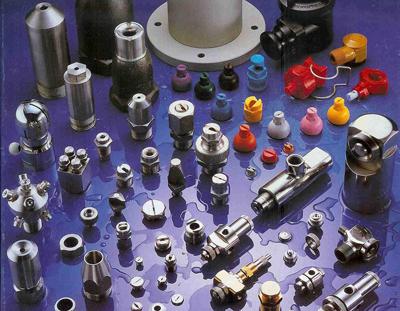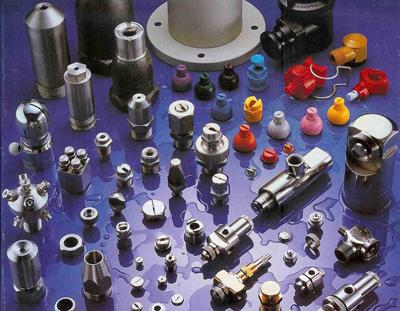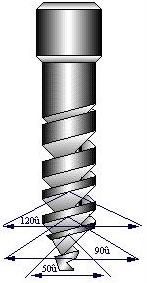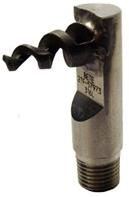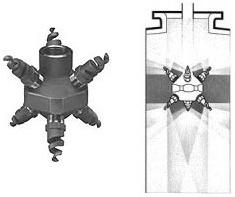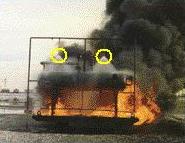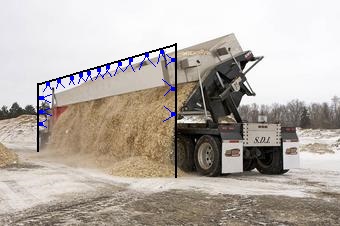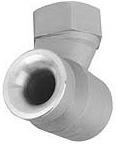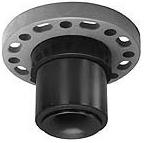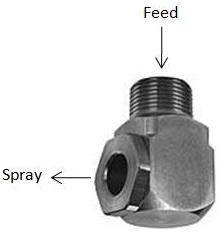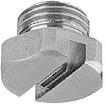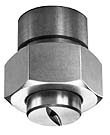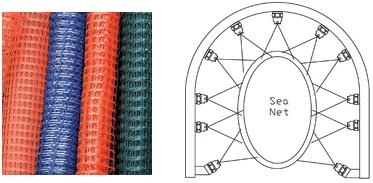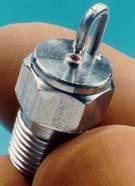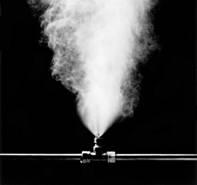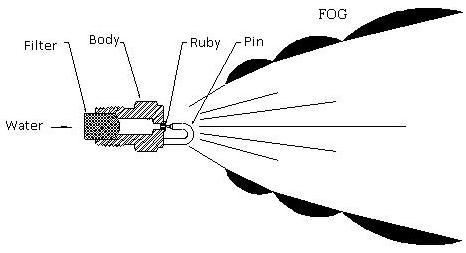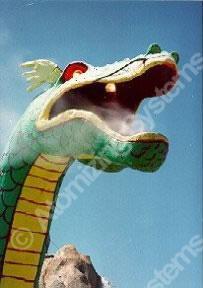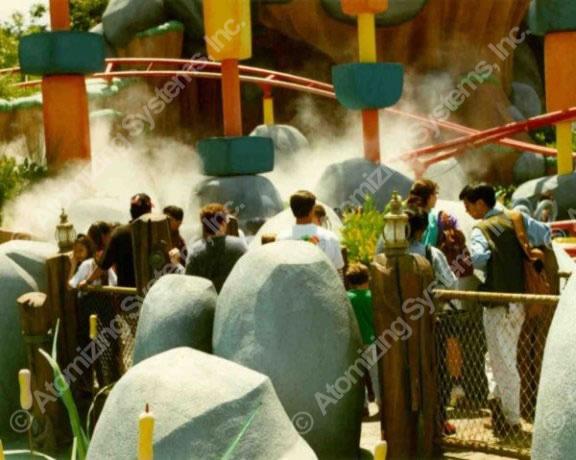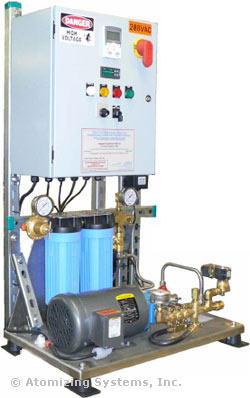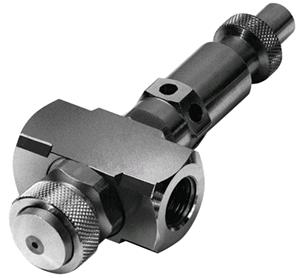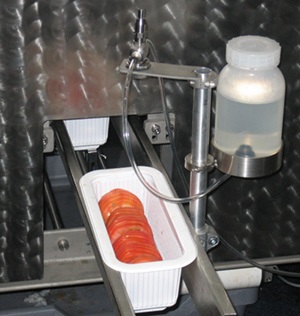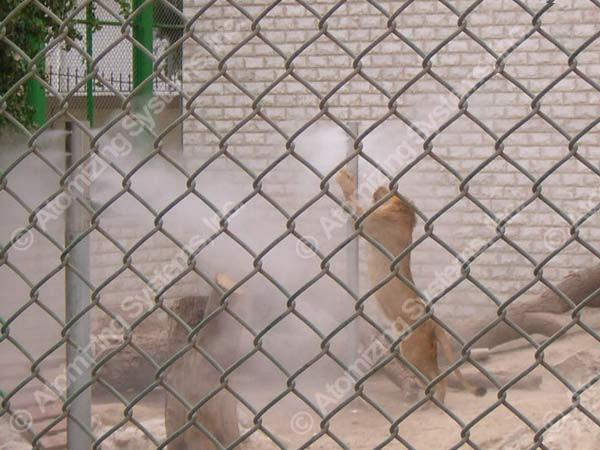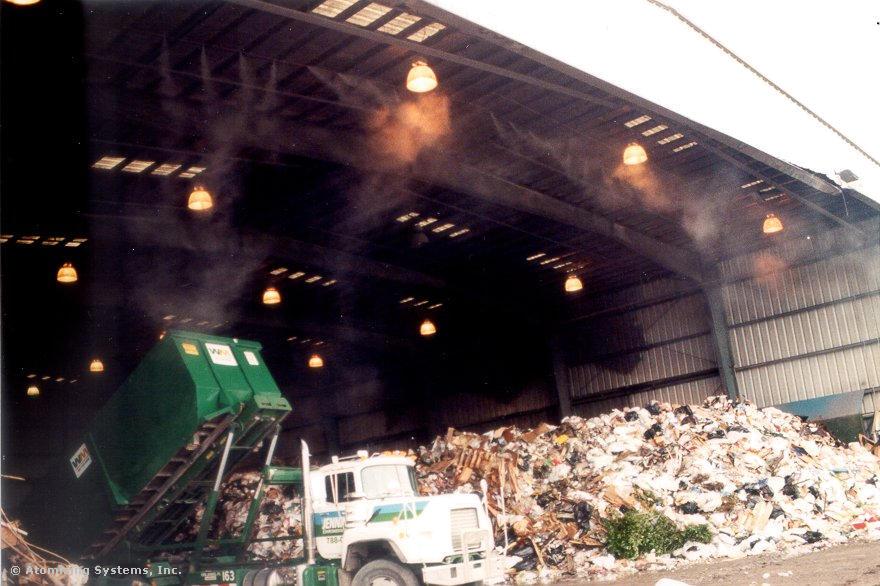Spiral
Spiral nozzles are characterized by the spiral fitting at the exit of the nozzle.
General Information
Spiral nozzles operate much the same way other nozzles do. A liquid stream enters the nozzle from the reservoir and flows along the body of the nozzle. As the liquid stream descends along the spiral, it is continuously atomized.
(Copyright BETE Fog Nozzle, Inc., Greenfield, MA)
Equipment Design
The distinguishing feature of spiral nozzles is the spiral fitting at the end of the nozzle. This fitting gives spiral nozzles a distinct spray pattern, as seen in the picture below.
The edge of the spiral controls the angle at which the fluid stream is discharged. Increasing the angle of the edge increases the discharge angle.
Spiral nozzles can be made from brass, bronze, cast iron, stainless steel, nickel alloy, ceramics, and synthetics, such as PVC. Spiral nozzles can also have different configurations, such as a right angle, as shown below. A nozzle like this could be used in a cooling tunnel to cool freshly filled beverage containers.
Usage Examples
Spiral nozzles are used in a wide variety of applications. Some of these include absorption, aeration, cooling, dust control, and fire protection.
The nozzle to the left produces a 180° cone. The one to the right is used to wash the inside of the process tanks.
(Copyright BETE Fog Nozzle, Inc., Greenfield, MA)
Spiral nozzles are also used for foam control, humidification, and scrubbing. The picture to the left shows spiral nozzles being used to extinguish a fire. Spiral nozzles can also be used for dust suppression applications, as shown on the right. When the sugar cane is offloaded from the truck it produces a lot of dust that can be hazardous to the workers, so spiral nozzles are used to suppress the dust.
(Copyright BETE Fog Nozzle, Inc., Greenfield, MA)
Advantages
- Low pump pressures are needed due to high discharge velocity
- Energy efficient
- No internal parts
- Little clogging
Disadvantages
- Expensive
- Complex design
Whirl
Whirl nozzles cause the fluid stream to be spun, or whirled, as it leaves the nozzle.
General Information
In whirl nozzles, the fluid stream enters the nozzle from the reservoir. Upon entering the nozzle body, the fluid is spun or “whirled.” The fluid stream then exits the end of the nozzle, where it is atomized.
(Copyright BETE Fog Nozzle, Inc., Greenfield, MA)
Equipment Design
Whirl nozzles are separated into two major types: axial and tangential. They differ in how fluid enters the nozzle.
The animation on the right and the picture on the left are axial whirl nozzles. In axial whirl nozzles, the fluid stream enters from the axial direction. Once inside the nozzle body, a spinning vane causes the fluid stream to “whirl”.
In tangential whirl nozzles, the fluid stream enters the nozzle body from the side. This causes the fluid to “whirl” and eliminates the need for an internal vane.
Whirl nozzles are capable of producing spray angles from 15° to 140°. They may be made from brass, bronze, cast iron, stainless steel, nickel alloys, ceramics, or synthetic materials, such as PVC.
Usage Examples
Whirl nozzles are used in a wide variety of applications, including aeration, cooling, disposal, distribution, dust control, etching, and fire protection.
The nuclear power plant below uses whirl nozzles in a cooling process.
Whirl nozzles, such as the one to the left, are also used for absorption, scrubbing, and washing. The whirl nozzle on the right is used for dry scrubbing.
(Copyright BETE Fog Nozzle, Inc., Greenfield, MA)
Advantages
- Uniform spray coverage.
- High flow rates.
- Wide range of spray angles.
Disadvantages
- Axial whirl nozzles are subject to clogging.
Fan
Fan nozzles are distinguished by their sheet-like spray pattern and are known for their uniform coverage.
General Information
In fan nozzles, the fluid stream enters the nozzle body from the top and is discharged through a small elliptical orifice.
Equipment Design
Fan nozzles atomize a fluid stream into a thin flat sheet or fan of spray using an elliptical orifice at the exit of the nozzle. A wedge is cut into the end of the nozzle, which constricts the flow of fluid, producing a spray. Changing the angle of the wedge changes the spray angle.
The exit stream from a fan nozzle strikes the wall in front of it to create a fan of spray.
Fan nozzles can be made from brass, bronze, cast iron, stainless steel, nickel alloys, ceramics, and synthetic materials, such as PVC. The spray angle can be from 0° to 120°.
(Copyright BETE Fog Nozzle, Inc., Greenfield, MA)
Usage Examples
Fan nozzles are used in many applications, including additives, air and steam, coatings, etching, fire protection, foam control, and washing applications.
Fan nozzles can be used to clean sea nets and remove the organic materials and marine organisms that collect on the nets after being submerged in seawater for several months.
Advantages
- No internal parts
- Uniform distribution
- Wide variety of spray angles
Disadvantages
- Clogging may occur
- Narrow range of coverage
Impingement
Impingement nozzles are able to produce the smallest particle sizes and are distinguished from other nozzles by the metal pin present at the exit of the nozzle.
General Information
Impingement nozzles operate much the same way as other nozzles. The fluid stream enters from the top of the nozzle and is discharged through a small orifice, where it hits a metal pin and is atomized.
Equipment Design
The distinguishing feature in impingement nozzles is the small metal pin that sits at the exit of the nozzle. The pin has the same diameter as the orifice at the end of the nozzle.
When the fluid stream strikes the pin, it is broken up into very fine particles, producing a fog.
(Copyright Atomizing Systems, Ho-Ho-Kus, NJ)
Impingement nozzles can be made from brass, stainless steel, nickel alloys, or titanium. They are usually designed so that they have a 90° spray angle, and produce a cone-shaped fog.
The diagram below highlights the components of an impingement nozzle. The nozzle illustrated below is a ruby-orifice impingement nozzle and has a long lifetime due to the ruby’s high abrasion resistance.
Usage Examples
Impingement nozzles, while not as popular as other types of nozzles, are most often used when a thin fog is desired. Some common applications are coating, cooling, and dust control.
Impingement nozzles are used to create fog as a special effect. In the picture to the left, many impingement nozzles are used to produce the smoke that comes from the dragon’s mouth, and the picture on the right shows fog effects in Disneyland ®.
(Copyright Atomizing Systems, Ho-Ho-Kus, NJ)
Impingement nozzles are also used in humidification and scrubbing applications. The humidification system shown below uses ruby-orifice impingement nozzles for humidity control.
Advantages
- High energy efficiency
- No internal parts
- Produces very fine droplets
Disadvantages
- Limited use compared to other nozzle types
- Small spray angle range
Air Atomizing
Air atomizing nozzles use air to aid in atomization.
General Information
Air atomizing nozzles operate much the same way as other nozzles. The major difference is that air is mixed with the fluid to be atomized, which aids in the atomization process.
Equipment Design
Air atomizing nozzles use compressed air to atomize fluid streams at low flow rates. They may be configured for internal or external mixing. Below is a diagram of an internal mixing nozzle.
With internal mixing, the air (yellow) and fluid (blue) are mixed inside the nozzle body and then discharged through the orifice (red). If the airflow rate changes, so will the fluid flow rate. Internal mixing generally produces finer atomization.
With external mixing, the air (yellow) and fluid (blue) streams leave through separate orifices and are mixed outside the nozzle body. This allows for independent control of the air and fluid streams. The degree of atomization can be adjusted by changing the airflow rate.
Usage Examples
Air atomizing nozzles are used in applications such as additives, air and steam, coatings, cooling, etching, and fire protection. The nozzle below sprays a small amount of sanitation solution into tomato packages before they get sealed and shipped.
Air atomizing nozzles are also used for humidification and scrubbing. For example, air atomizing nozzles are used for odor control in the Kuwait Zoo, shown on the left, and a trash transfer station in Florida, shown on the right.
(Copyright Atomizing Systems, Ho-Ho-Kus, NJ)
Advantages
- Two fluids may be handled at once
- Usable in hostile environments
Disadvantages
- Complex design
Acknowledgements
- Atomizing Systems, Ho-Ho-Kus, NJ
- BETE Fog Nozzle, Inc., Greenfield, MA
- Bergman Specialty Products, Jackson, MI
- Lechler Inc., St. Charles, IL
References
- McCabe, Warren L., Harriot, Peter, and Smith, Julian C. Unit Operations of Chemical Engineering. 5th ed. New York: McGraw-Hill, 1993: 126-127. Print.
- Perry, Robert H. and Don W. Green. Perry’s Chemical Engineers’ Handbook. 7th ed. New York: McGraw-Hill, 1997: 27-34 – 27-35. Print.
Developers
- Sam Catalano
- Steve Wesorick
- Joseph Palazzolo
- Mathew Robertson
- Kelsey Kaplan

